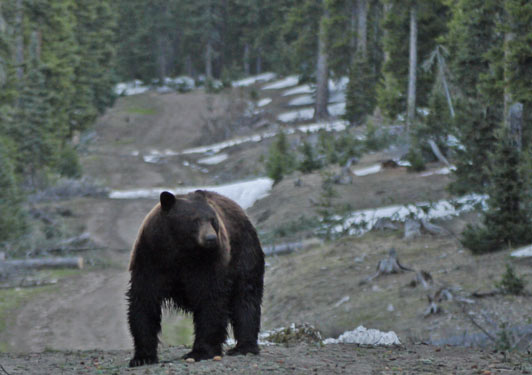
Fear, Danger, and Emergencies
People have often asked me whether I'm afraid while I'm out hiking. I guess they watch TV and see a never ending series of 'Reality' shows where people are suffering through horrible deaths from Spider and Snake Bites, Alligators, Rutting Moose Bulls, Bears, Wolves, Cougars and Badgers, Giardiasis, Cryptosporidiosis, Rocky Mountain Spotted Fever, Lyme Disease, Heat Exhaustion, Hypothermia, Drowning, Burial by Avalanche, Falling off Cliffs, Burning up in Wildfires...
Geez Louise!
I haven't died even once in decades of hiking...
All of the above dangers and many more are a real part of hiking. But we can educate ourselves about them. And with that education, we can avoid the dangers, we can act appropriately when we've failed to avoid the dangers, and when an emergency has occurred, we can treat our injuries appropriately. In reality, I've never been seriously injured while hiking, and the times when I've been in significant danger were very few.
And actually, I think I'm in much more danger in town than I ever am out hiking. Just about every day in town I drive on or walk across busy streets. People drive too fast and pay more attention to their cell phones than the road, so the danger of accidents is very real. Most people are honest, but in a city, there are probably criminals somewhere nearby. Every winter I get a few slight colds or flus... So in the city, there are significant dangers every day.
But while out hiking, most days there are no significant dangers. And often, if there are dangers, I can protect myself in various ways. For safety, I'll stick with hiking.
Fear
Fear can be a good thing. Sometimes the first warning we have of a bad situation is some sense of dread, or our hairs raising. If we pay attention to that warning, and examine our environment, maybe we will find a snake on the trail, or some other danger. Good. For a few yards we can leave the trail and walk around the snake. Or maybe we're afraid after looking at a stream crossing: It's too deep, too swift, and there's a waterfall just downstream. Good. Crossing there would be insane. Now we can go upstream or downstream to find an appropriate crossing spot, or turn back. Fear can tell us that it's not safe to just continue on. If we properly apply fear, we then turn on our rational brains and decide what to do next.
Lack of Fear can be a very bad thing. Most venomous snake bites are to the hands and forearms of young males. It's too bad these guys weren't too afraid to try to hand catch a venomous snake. Just a little bit of fear would have done the job. Overly brave young men do a lot of other dumb things and get hurt.
Too Much Fear might keep us from doing hiking at all. Sure you might see a snake or spider, etcetera. But you probably won't. And if you do, you can take steps to avoid being bitten. And if you are bitten, you can take care of yourself and, if necessary, eventually go to a hospital.
Panic can cause overly dangerous responses to problems that could have been solved. If we see a spider we could easily have avoided, and turn and run right into a cactus, it's just not worth it. If we fall in a creek, there's a pretty good chance we can wade or swim out. Panic will only decrease our chances of survival.
So the idea is to control our fear to just the right level to keep ourselves from doing stupid things, while still hiking or doing whatever else keeps us happy and healthy.
Danger
There are very real dangers to hiking. For most dangers, as long as we recognize the danger and know something about it, we can do something to avoid it. Knowledge, education, and experience weigh nothing, so we can carry as much as we want along the trail. Having knowledge enough to recognize a threat, and of what steps to take to reduce the danger from the threat, is our primary way of mitigating danger along the trail.
Experience
There is a tradition among long distance hikers that they first hike the Appalachian Trail, then the Pacific Crest Trail, and finally the Continental Divide Trail.
This gives inexperienced hikers a chance to learn and gain experience on the AT, with lots of other hikers around to offer advice and help if required. The Pacific Crest Trail requires more navigation, and more attention to whether you need to carry water long distances. The CDT has even more navigation and water issues, with many fewer hikers to help out should an emergency occur. One point here is that hikers should pick trails that are appropriate to their experience levels. A second point is that we can accumulate experience on trails that we can presently handle that will enable us to safely undertake tougher trails later.
The dangers mitigated by general hiking experience include getting lost, running out of food or water, dealing with predators and venomous animals, and many other things.
Medical
Depending on the trail chosen, it's fairly likely that there will be times when it would take several days to walk to the nearest trailhead or town, and that you would meet no other hikers for several days. This means that you would need to be able to take care of yourself and your partners possibly for several days after an injury or other medical problem.
Cell phones might be used to summon help, but you might need to walk quite a distance to someplace with reception. Some hikers carry various types of satellite transponders so they can summon help from virtually anywhere.
It would be wise to have some sort of first aid training appropriate to the backcountry. Unfortunately, most first aid classes teach you to call 911 and take care of the patient for 10-15 minutes while an ambulance comes. Wilderness focused first aid classes teach you to care for people for days, in backcountry settings, and with improvised equipment. Wilderness First Responder classes take 8-10 days. Classes that take longer than WFR usually focus on the use of medical equipment a hiker is not likely to have in the field, so WFR is the longest, most thorough class that is fully useful to hikers. Shorter classes are also available, of course. It would be best to take the longest class for which you can afford the time and cost. Wilderness Medical Associates (WMA), Stonehearth Open Learning Opportunities (SOLO), and Wilderness Medicine Institute (WMI / NOLS) offer backcountry focused first aid classes.
Taking these classes is important because it is unlikely that by just hiking we will ever accumulate enough experience to know how to diagnose and treat the many medical problems that occasionally show up while hiking. Also, book learning is excellent, but practicing on people, and under the observation and advice of experienced people, is necessary to learn how to diagnose and treat problems.
Hitchhiking
Most long distance hikers get more food and other supplies by hitchhiking to towns and picking up packages at the post office or buying it in the local stores. In hitchhiking, you stick your thumb out long before you can see the faces of the people in the cars. So it's possible you might stop someone you should not ride with. So if the driver seems drunk, or you get any bad feeling after meeting the people in the car, just don't take the ride. If they seem to need an excuse, just say "Oh crap, I left my camera 10 minutes back on the trail - I'll get another ride later..." It's better to lie than die.
Male versus Female
While hitchhiking and in towns, perhaps women would be in more danger than men. So being extra careful is a good idea. You could always mention that your partners are coming down the trail any minute, whether or not you have any. And there are classes in awareness and self defense. But for most situations in hiking, there is no extra danger for women.
Heat and Dehydration
There is a spectrum of problems caused by heat and dehydration. Our bodies keep cool by sweating, losing water through our skin. If we lose too much water, our bodies and brains cannot function properly. Heat stroke is a body temperature of over 105°F. As we become dehydrated and hot, cramps, mental problems, fainting, and death are possible. To avoid heat problems, we must remain well hydrated, and on especially hot days, we must find shade and quit exercising. In the deserts, hiking early in the morning, resting through the early afternoon, and finishing the day's hike after temperatures drop, may be necessary.
Animals
It's interesting and perplexing to me that people who never hike are often terrified by alligators, bears, snakes, and etcetera. I have had many encounters, but in most cases, the animal had either no interest in me or left the area as soon as possible. Only once have I been injured by an animal. That was a Brown Recluse Spider, which I never saw.
Black Bear

Mammal Predators
I've seen bears, wolves, coyotes, fox, cougars, bobcats, and badgers out on the trail. All are perfectly capable of attacking me if they wished to do so. In fact, I have no fighting skills or practice, and no weapons, so if they did attack, all I could do is throw a rock, run away, or play dead. These animals chase down and kill other animals for a living, so they are very skilled and practiced, and I would have no chance at all.
|
Family | Genus | Species | Common Name | ||||||||
| Canidae Dogs |
Canis | latrans | Coyote | |||||||||
| lupus | Gray Wolf | |||||||||||
| lupus familiaris | Domestic Dog | |||||||||||
| Urocyon | cinereoargenteus | Gray Fox | ||||||||||
| Vulpes | macrotis | Kit Fox | ||||||||||
| vulpes | Red Fox | |||||||||||
| Felidae Cats |
Felis | catus | Domestic Cat | |||||||||
| Lynx | canadensis | Canada Lynx | ||||||||||
| rufus | Bobcat | |||||||||||
| Puma | concolor | Cougar | ||||||||||
| Mustelidae Weasels |
Taxidea | taxus | American Badger | |||||||||
| Ursidae Bears |
Ursus | americanus | Black Bear | |||||||||
| arctos | Grizzly Bear | |||||||||||
| maritimus | Polar Bear |
Fortunately, these animals are somewhat related to domestic cats and dogs. If you can recognize that a domestic cat or dog is snarling, growling, or looking defensive, then you know the signs that mammalian predators show when they are scared and wish you would go away. If they have food or children around, they will be defensive. They will appear less scared but just as threatening. We mitigate this threat by backing slowly away, then walking away. (Never run away, as this may trigger a reflex to chase and kill you.) If the animal is blocking the trail, walk back several minutes and then walk cross country around, far enough from the animal to not bother them. If there's no way around, just walk back a mile and take a long break before proceeding. If there's a large carcass near the trail, the predators won't leave and will defend the area until it's gone, perhaps a week or more. So find some other way of getting around.
Each animal has a distance from you at which it feels comfortable. You may notice that the animal is very uncomfortable when you first walk around a corner and are close. But then when you or the animal retreat a little, perhaps it goes back to its business, just checking on you occasionally. You can see in the expression of the animal that it is much more comfortable. Understanding this 'comfortable distance' and backing off so the animal feels safe is key to getting along with predators and other wild mammals.
Nuisance Animals
Squirrels, marmots, other rodents, and bears can learn to steal your food. This usually happens where there are a lot of amateur hikers in the area, like on the Appalachian Trail, or in Yosemite and Yellowstone National Parks. When one hiker after another leaves peanuts, bread, and soup laying around, the animals learn that this is an excellent source of a lot of calories, and that it's a lot easier to steal it from you than to collect the same food value in nature. So they chew through your pack, tent, etcetera, and start chewing on your food, getting their saliva on it and unsealing all the packages, potentially ruining a lot more food than they actually eat. Now you need to repair gear and you're short on food. Squirrels and bears may also carry ticks which might drop off and later attack you. You can avoid these problems by hanging or bearboxing your food, and by not camping in well used campsites. Any site that is used regularly is visited by trained squirrels and bears. So if you walk several hundred feet to the side of the trail in some random spot and camp there, you are less likely to be visited by camp raiders.
Alligators
There are alligators Alligator mississipiensis and crocodiles Crocodylus acutus in the southeastern United States. They make their living by catching things swimming or walking along the shore. They do this by floating near to and facing the shore, with just their eyes showing. Their huge muscular tails allow them to accelerate very quickly onto the shore and bite down on any animal by the water. They can run too, but mostly they want things in or near the water.
Alligator
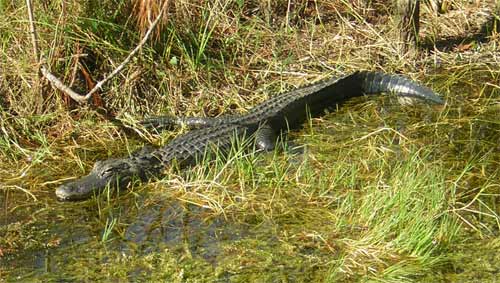
Usually, they are not interested in catching something as large as an adult human, because they are not able swallow something that large. If they do catch something that large, they need to stash it someplace to rot a while, until they can easily tear off chunks, as they are not well equipped to bite pieces off a large animal. Something the size of a toddler or small dog is ideal. So while walking your dog or kid near water in the southeast is stupid, hiking near water is fairly safe for adult hikers.
The exception is that sometimes alligators get accustomed to getting food from people. So where there is a lot of fishing tackle, or fish guts, or food garbage around, it's best to stay well away from the water.
On the Florida Trail, it's fairly common to walk on a causeway no wider than a dirt road, with alligators sunning themselves. Usually I've just walked past them, with no problems. If they were behaving in some threatening manner, or seemed to have some special interest in me, I'd back off a good distance and rest for an hour or two, hoping the alligator would go away before I returned and got through.
A lot of water bodies in the southeast are dirty or tannic enough that you can't see through them. That means you can't see an alligator, and he can't see you. He might mistake you for a fish and bite. So swimming there seems dumb to me.
Venomous Reptiles
In the United States, there are crotalid snakes (Rattlesnakes, Copperheads, Water Moccasins, Cottonmouths), Coral Snakes, and Gila Monsters (lizards) which can bite you and inject venom.
| Some Crotalids or Pit Vipers | ||
|---|---|---|
| Common Name | Genus | Species |
| Eastern Diamondback Rattlesnake | Crotalus | adamanteus |
| Western Diamondback Rattlesnake | atrox | |
| Sidewinder | cerastes | |
| Timber Rattlesnake | horridus | |
| Rock Rattlesnake | lepidus | |
| Speckled Rattlesnake | mitchellii | |
| Black-Tailed Rattlesnake | molossus | |
| Western Rattlesnake | oreganus | |
| Twin-Spotted Rattlesnake | pricei | |
| Red Diamond Rattlesnake | ruber | |
| Mohave Green Rattlesnake | scutulatus | |
| Tiger Rattlesnake | tigris | |
| Prairie Rattlesnake | viridis | |
| Ridge-Nosed Rattlesnake | willardi | |
| Copperhead | Agkistrodon | contortrix |
| Cottonmouth or Water Moccasin |
piscivorus | |
Eastern Diamondback Rattlesnake, Crotalus adamanteus
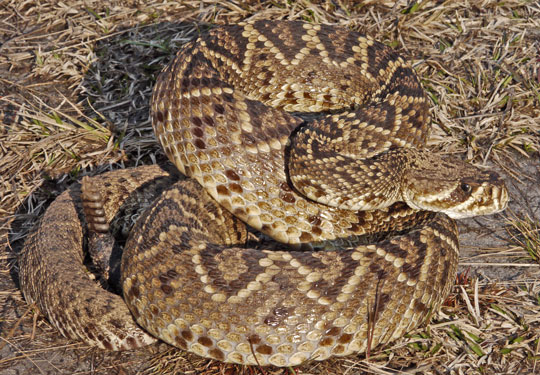
Crotalids, or Pit Vipers, are all over the 48 states. They have triangular heads and often have distinctive diamond patterns on their backs. If swelling, bruising, pain, and etcetera start after being bit, you have been envenomated. Especially with the Mojave Green Rattlesnake, even without these symptoms, you may have a deadly dose of venom. Getting bit by a snake is not a normal thing, so you should probably head for a hospital right away. Unfortunately, you also need to keep the bitten part fairly still and limit exercise to avoid spreading the venom through your body. So picking the easiest path to a road where you can hitchhike is a good idea. Many times, crotalids don't inject venom when they bite. So hopefully, there will be no venom and no symptoms. Keep in mind, though, that you still have a bite wound with saliva from an animal that eats rodents for a living, so monitor it carefully for infection.
| United States Coral Snakes | ||
|---|---|---|
| Common Name | Genus | Species |
| Eastern or Common Coral Snake | Micrurus | fulvius |
| Texas Coral Snake | tener | |
| Arizona Coral Snake | Micruroides | euryxanthus |
Coral Snakes live in the southern tier of states. They have red, black, and yellow-white bands around their bodies. In North American Coral Snakes, the red and yellow-white bands are adjacent. If the red and yellow-white bands are not adjacent, the snake is non-venomous. Some non-venomous species that look like coral snakes are listed below. Coral Snakes have to chew on you to inject venom. Again, it should not be a normal thing for snakes to be chewing on you. And again, start evacuating to a hospital. If no venom was injected, you can get back to your hike later.
| Non-Venomous Snakes with Red, Black, and White-Yellow Bands | |
|---|---|
| Common Name | Genus |
| Scarlet Snake | Cemophora |
| some Kingsnakes and Milk Snakes | Lampropeltis |
| Shovelnose Snake | Chionactis |
Gila Monsters, Heloderma suspectum are large, distinctivly colored lizards living in the southwest. You're likely to see them on the CDT, Arizona Trail, and Grand Enchantment Trail in Arizona and New Mexico. Like Coral Snakes, they chew to inject venom. Just one more time, I hope that large lizards chewing on you is not a regular occurrence. Most Gila monster bites are not fatal, but they can make you quite sick and be painful. Start heading out, and hope that the trip to the hospital turns out to be pointless.
Gila Monster, Heloderma suspectum
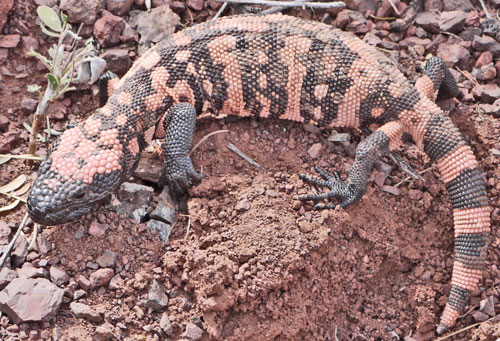
If you see any of these venomous reptiles, stay several feet away, and walk around them. They don't chase you.
Bugs, Spiders, Etcetera
There are all sorts of horrible biting insects: Mosquitoes Aedes, Black Flies Simulium, Deer Flies Chrysops, Horse Flies Tabunus punctifer, No-see-ums, etcetera. Fortunately, while some mosquito vectored disease epidemics have occurred in US urban areas, they don't seem to have taken hold out in the wild. Ticks, on the other hand, carry enough diseases that I've written an entire chapter on them. Spiders and scorpions can inject venom and cause allergic reactions. Sometimes they kill flesh near the bite or cause whole body reactions. If you've been bitten by any sort of bug and have any sort of reaction, it's probably best to go see the doctor.
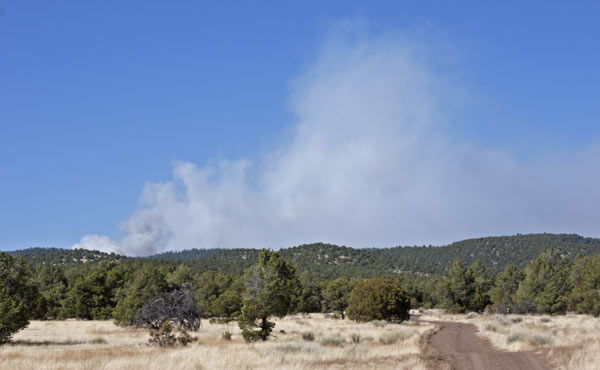
Wildfires
Anytime a long distance hiker sees or smells a great deal of smoke, he must be concerned about the possibility of wildfires. Knowing the direction to the fire and checking whether the trail ahead is near it is critical. Discovering possible escape routes by examining maps is a part of planning for dealing with wildfires.
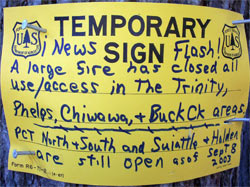
Emergencies
Seeing and avoiding dangers has always worked for me: I've never had an emergency while hiking. Still, we need to be prepared. Here are a few thoughts:
Summoning Help
If you're hiking on the PCT or AT in the prime season, finding help may be as simple as sitting down and waiting a few minutes. If you're out of sight and shouting distance of the trail, or on some little travelled route, it may be quite a long time before anyone finds you. So maybe if you leave the trail, you should be extra careful, and you should have means to summon help.
Cell phones may only work if you hike to some spot with good reception. Satellite phones and beacons are carried by some hikers for this reason. Still, they might not work in a deep canyon. Where reception is likely to be poor, extra care and a plan to walk the device to a useable area are warranted.
Before summoning help, think about whether it's smarter to help yourself. If you can walk out, that's a lot faster than someone walking out, summoning a rescuer, them walking in, then you walking out with them. Rescues may risk a lot of people, and helicopter rescues are especially dangerous.
Medical Emergencies
If you've taken a class and read some books, you'll be much better prepared for some type of medical emergency. If you know nothing, you'll be pretty helpless.
Snow and Rock Avalanches
There are excellent classes on how to avoid snow avalanches and how to rescue people from them. If you're going to hike in a great deal of snow, taking one would be a good idea.
If someone has just been buried, it's fairly likely the snow or rock is still unstable and will slide again, especially as you're climbing around and digging in it. If you really don't know where the victim is, it may be more dangerous than it's worth to climb through the unstable area looking for them.
Avoid Excess Risk
As a general principle, before responding to any emergency, make sure you'll be safe. Ensure the snake is gone, that you won't fall off the same cliff, you won't catch the same diarrhea, or that you won't be mauled by the same bear. After all, having two people in trouble is much worse than one in trouble and one able to help.
Being Prepared
Your response to any emergency will depend on your skills and equipment, any help that may be available, your distance from society, and many other factors. You should always have appropriate training, knowledge, and skills for whatever risks you're taking. You should be roughly aware of escape routes and of where help may be found. Being prepared will make your response to some emergency faster and more effective.